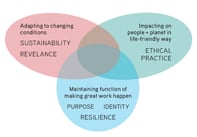Planetary change
The arts sector says it is keen to engage with the problems facing the planet, but Nadine Andrews wonders if it is really connecting with the important issues?

Several events for the cultural sector have recently included keynote speeches about the challenges facing our planet. I’ve found listening to the ensuing discussions quite disappointing – the level of debate has so often been so… small. Something seems to go missing in translating these big environmental issues to cultural business models and working practice, even when people are active on these issues in their personal lives.
When impact on the quality of life, on human well-being or on nature and natural resources is being discussed, I hear much more about it in terms of the instrumental value of arts and culture (to support the case for public funding) than from the perspective of recognising the responsibility we have for the consequences of our actions. I see a fundamental difference between these two motivations for assessing impact, but find that this distinction is rarely made explicit – perhaps it is not fully appreciated or understood. In any case it means that there is a certain insularity to the conversation.
THE BIGGER PICTURE?
In Mission Models Money’s (MMM) recent ‘People Theme’ research into competencies and attributes needed in the arts sector for it to thrive during periods of complexity, change and uncertainty (AP210) more than half of respondents thought that they were very good at seeing the bigger picture. I am wondering just what this bigger picture actually is, and suspect that many in our sector see a bigger picture that is missing a few vital elements. The importance of biodiversity and natural ecosystems to human economies and therefore to the health of the sector seem to be blind spots: these interdependencies appear not to be readily recognised.
Most organisations are probably trying to lower their carbon footprint, but how many actively encourage local biodiversity? Or are aware of the toxicity of materials used in the processes of producing and presenting artwork; or are converting waste into food; or indeed are really concerned with the well-being and quality of life at work of staff and other stakeholders?
The UK arts and cultural sector is only partially, tenuously, connected to the bigger picture. The sector can be very good at exploring the big themes through art, and art has a unique and vital role in helping us re-imagine the future and how we can live in it. But consider how vastly more powerful the message would be if it were truly congruent – if the art produced about these issues was matched by a deep systemic interrogation of its contribution through its business practices to the state of life on the planet.
As it stands, the sector is in danger of lagging behind as organisations and companies in other areas and parts of the world are switching on to this agenda of impact on human well-being and on nature and natural resources, the ‘Triple P’ of people, planet and prosperity. The New Economics Foundation’s Happy Planet Index describes a successful society as one that can “support good lives that don’t cost the Earth.” The MMM research defined “thriving” as the integration of three dimensions of relevance, resilience and ethical practice as shown below. ‘Life-friendly’ means having a benign impact on quality of life – all life.
Sounds great but what does it mean in practice? To find out I am working with the Chinese Arts Centre in Manchester to explore how the organisation functions, and to see what can be done to increase the life-friendliness of its impact; to identify what the barriers and challenges are and how they can be overcome; to examine the implications of adopting a solution; and to identify appropriate and relevant indicators for assessing impact. We will be working throughout with an artist who will then produce work that is influenced by the research themes and discoveries, and by their own experiences of the project.
There is currently no single user-friendly, holistic, practical and meaningful model that integrates impact on both well-being and nature. The research therefore seeks to address this by producing such a model, making it easier for organisations to know what to do to have a more benign impact.
HAPPY PLANET
The Happy Planet Index’s associated Charter for a Happy Planet calls for governments to “measure people’s well-being and environmental impact in a consistent and regular way, and to develop a framework of national accounts that considers the interaction between the two so as to guide us towards sustainable well-being”. The forthcoming UN report ‘The Economics of Ecosystems and Biodiversity’ is expected to recommend that financial reporting also takes account of natural and human capital. I anticipate that in the not-so-distant future, organisations will have to report on impact on well-being and nature/natural resources as a condition of funding, in which case this research will be well placed to inform what indicators get used. In starting this project to activate the sector towards this new life-friendly vision, I am inspired and energised by the words: “If not us, who? If not now, then when?”
Join the Discussion
You must be logged in to post a comment.